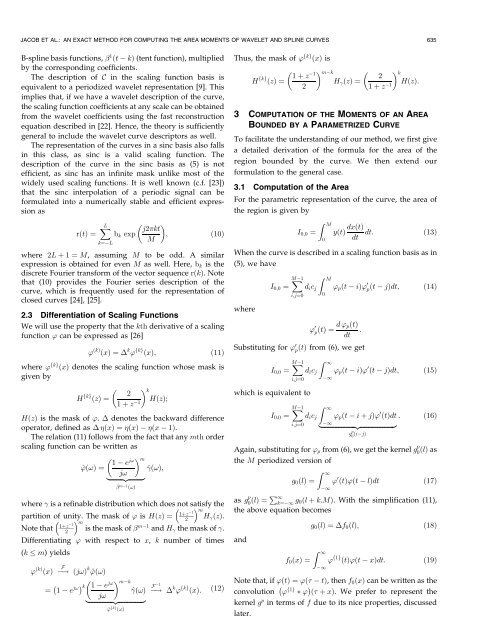An exact method for computing the area moments of ... - IEEE Xplore
An exact method for computing the area moments of ... - IEEE Xplore
An exact method for computing the area moments of ... - IEEE Xplore
- No tags were found...
Create successful ePaper yourself
Turn your PDF publications into a flip-book with our unique Google optimized e-Paper software.
JACOB ET AL.: AN EXACT METHOD FOR COMPUTING THE AREA MOMENTS OF WAVELET AND SPLINE CURVES 635B-spline basis functions, 1 …t k† (tent function), multipliedby <strong>the</strong> corresponding coefficients.The description <strong>of</strong> C in <strong>the</strong> scaling function basis isequivalent to a periodized wavelet representation [9]. Thisimplies that, if we have a wavelet description <strong>of</strong> <strong>the</strong> curve,<strong>the</strong> scaling function coefficients at any scale can be obtainedfrom <strong>the</strong> wavelet coefficients using <strong>the</strong> fast reconstructionequation described in [22]. Hence, <strong>the</strong> <strong>the</strong>ory is sufficientlygeneral to include <strong>the</strong> wavelet curve descriptors as well.The representation <strong>of</strong> <strong>the</strong> curves in a sinc basis also fallsin this class, as sinc is a valid scaling function. Thedescription <strong>of</strong> <strong>the</strong> curve in <strong>the</strong> sinc basis as (5) is notefficient, as sinc has an infinite mask unlike most <strong>of</strong> <strong>the</strong>widely used scaling functions. It is well known (c.f. [23])that <strong>the</strong> sinc interpolation <strong>of</strong> a periodic signal can be<strong>for</strong>mulated into a numerically stable and efficient expressionasr…t† ˆ XLkˆLb k expj2kt ; …10†Mwhere 2L ‡ 1 ˆ M, assuming M to be odd. A similarexpression is obtained <strong>for</strong> even M as well. Here, b k is <strong>the</strong>discrete Fourier trans<strong>for</strong>m <strong>of</strong> <strong>the</strong> vector sequence r…k†. Notethat (10) provides <strong>the</strong> Fourier series description <strong>of</strong> <strong>the</strong>curve, which is frequently used <strong>for</strong> <strong>the</strong> representation <strong>of</strong>closed curves [24], [25].2.3 Differentiation <strong>of</strong> Scaling FunctionsWe will use <strong>the</strong> property that <strong>the</strong> kth derivative <strong>of</strong> a scalingfunction ' can be expressed as [26]' …k† …x† ˆ k ' fkg …x†;…11†where ' fkg …x† denotes <strong>the</strong> scaling function whose mask isgiven by H fkg 2 k…z† ˆ1 ‡ z 1 H…z†;H…z† is <strong>the</strong> mask <strong>of</strong> '. denotes <strong>the</strong> backward differenceoperator, defined as …x† ˆ…x†…x 1†.The relation (11) follows from <strong>the</strong> fact that any mth orderscaling function can be written as^'…!† ˆ 1 mej!^…!†;j!|‚‚‚‚‚‚‚‚{z‚‚‚‚‚‚‚‚}^ m1 …!†where is a refinable distribution which doesnot satisfy<strong>the</strong>mHpartition <strong>of</strong>unity.The mask <strong>of</strong> ' is H…z† ˆ 1‡z12…z†.m1‡zNote that12 is <strong>the</strong> mask <strong>of</strong> m1 and H <strong>the</strong> mask <strong>of</strong> .Differentiating ' with respect to x, k number <strong>of</strong> times(k m) yields' …k† …x† ! F … j! † k ^'…!† ˆ 1 e j! k 1 e j! mk^…!†j!|‚‚‚‚‚‚‚‚‚‚‚‚‚‚‚{z‚‚‚‚‚‚‚‚‚‚‚‚‚‚‚}^' fkg …!†!F 1 k ' fkg …x†: …12†Thus, <strong>the</strong> mask <strong>of</strong> ' fkg …x† isH fkg …z† ˆ 1 ‡ mk z12 kH …z† ˆ21 ‡ z 1 H…z†:3 COMPUTATION OF THE MOMENTS OF AN AREABOUNDED BY A PARAMETRIZED CURVETo facilitate <strong>the</strong> understanding <strong>of</strong> our <strong>method</strong>, we first givea detailed derivation <strong>of</strong> <strong>the</strong> <strong>for</strong>mula <strong>for</strong> <strong>the</strong> <strong>area</strong> <strong>of</strong> <strong>the</strong>region bounded by <strong>the</strong> curve. We <strong>the</strong>n extend our<strong>for</strong>mulation to <strong>the</strong> general case.3.1 Computation <strong>of</strong> <strong>the</strong> AreaFor <strong>the</strong> parametric representation <strong>of</strong> <strong>the</strong> curve, <strong>the</strong> <strong>area</strong> <strong>of</strong><strong>the</strong> region is given byZ MI 0;0 ˆ y…t† dx…t† dt:…13†0 dtWhen <strong>the</strong> curve is described in a scaling function basis as in(5), we havewhereXM1 Z MI 0;0 ˆ d i c ji;jˆ00' p …t i†' 0 p …t j†dt; …14†' 0 p …t† ˆd' p…t†:dtSubstituting <strong>for</strong> ' 0 p…t† from (6), we getXM1 Z 1I 0;0 ˆ d i c j ' p …t i†' 0 …t j†dt;i;jˆ0which is equivalent to1…15†XM1 Z 1I 0;0 ˆ d i c j ' p …t i ‡ j†' 0 …t†dti;jˆ0 1|‚‚‚‚‚‚‚‚‚‚‚‚‚‚‚‚‚‚‚‚{z‚‚‚‚‚‚‚‚‚‚‚‚‚‚‚‚‚‚‚‚}g p 0 …ij† : …16†Again, substituting <strong>for</strong> ' p from (6), we get <strong>the</strong> kernel g p 0…l† as<strong>the</strong> M periodized version <strong>of</strong>g 0 …l† ˆZ 11' 0 …t†'…t l†dt…17†as g p 0…l† ˆP1kˆ1 g 0…l ‡ k:M†. With <strong>the</strong> simplification (11),<strong>the</strong> above equation becomesandf 0 …x† ˆg 0 …l† ˆf 0 …l†;Z 11' f1g …t†'…t x†dt:…18†…19†Note that, if '…t† ˆ'… t†, <strong>the</strong>n f 0 …x† can be written as <strong>the</strong> convolution ' f1g ' … ‡ x†. We prefer to represent <strong>the</strong>kernel g p in terms <strong>of</strong> f due to its nice properties, discussedlater.
















